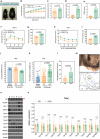High-fat diet induces depression-like phenotype via astrocyte-mediated hyperactivation of ventral hippocampal glutamatergic afferents to the nucleus accumbens
- PMID: 36180573
- PMCID: PMC9734059
- DOI: 10.1038/s41380-022-01787-1
High-fat diet induces depression-like phenotype via astrocyte-mediated hyperactivation of ventral hippocampal glutamatergic afferents to the nucleus accumbens
Abstract
Comorbidity exists between metabolic disorders and depressive syndrome with unclear mechanisms. To characterize the causal relationship, we adopted a 12-week high-fat diet (HFD) to induce metabolic disorder and depressive phenotypes in mice. Initially, we identified an enhanced glutamatergic input in the nucleus accumbens of HFD mice. Retrograde tracing and chemogenetic inhibition showed that the hyperactive ventral hippocampal glutamatergic afferents to the nucleus accumbens determined the exhibition of depression-like behavior in HFD mice. Using lentiviral knockdown and overexpression approaches, we proved that HFD-induced downregulation of glial glutamate transporters, GLAST and GLT-1, contributed to the observed circuit maladaptations and subsequent depression-like behaviors. Finally, we identified a potential therapeutic agent, riluzole, which could mitigate the HFD-induced behavioral deficits by normalizing the expressions of GLAST and GLT-1 and ventral hippocampal glutamatergic afferents to the nucleus accumbens. Overall, astrocyte-mediated disturbance in glutamatergic transmission underlies the metabolic disorder-related depressive syndrome and represents a therapeutic target for this subtype of depressive mood disorders.
© 2022. The Author(s).
Conflict of interest statement
The authors declare no competing interests.
Figures





Similar articles
-
Reduction of Dietary Fat Rescues High-Fat Diet-Induced Depressive Phenotypes and the Associated Hippocampal Astrocytic Deficits in Mice.Metabolites. 2025 Jul 18;15(7):485. doi: 10.3390/metabo15070485. Metabolites. 2025. PMID: 40710585 Free PMC article.
-
High-fat diet suppresses the astrocytic process arborization and downregulates the glial glutamate transporters in the hippocampus of mice.Brain Res. 2018 Dec 1;1700:66-77. doi: 10.1016/j.brainres.2018.07.017. Epub 2018 Jul 17. Brain Res. 2018. PMID: 30009766
-
High-fat diet and chronic restraint stress exacerbate anxiety-depressive behaviors via astrocytic A1 phenotype transformation.Sci Rep. 2025 Apr 29;15(1):15031. doi: 10.1038/s41598-025-99355-4. Sci Rep. 2025. PMID: 40301496 Free PMC article.
-
High-fat diet reduces the hippocampal content level of lactate which is correlated with the expression of glial glutamate transporters.Neurosci Lett. 2018 Jan 1;662:142-146. doi: 10.1016/j.neulet.2017.10.024. Epub 2017 Oct 16. Neurosci Lett. 2018. PMID: 29051084
-
Astrocyte control of glutamatergic activity: Downstream effects on serotonergic function and emotional behavior.Neuropharmacology. 2020 Apr;166:107914. doi: 10.1016/j.neuropharm.2019.107914. Epub 2019 Dec 14. Neuropharmacology. 2020. PMID: 32045742 Review.
Cited by
-
Time-restricted feeding prevents memory impairments induced by obesogenic diet consumption, via hippocampal thyroid hormone signaling.Mol Metab. 2024 Dec;90:102061. doi: 10.1016/j.molmet.2024.102061. Epub 2024 Nov 6. Mol Metab. 2024. PMID: 39515608 Free PMC article.
-
Bridging metabolic syndrome and cognitive dysfunction: role of astrocytes.Front Endocrinol (Lausanne). 2024 May 10;15:1393253. doi: 10.3389/fendo.2024.1393253. eCollection 2024. Front Endocrinol (Lausanne). 2024. PMID: 38800473 Free PMC article. Review.
-
Visceral adipose tissue-derived extracellular vesicles promote stress susceptibility in obese mice via miR-140-5p.Acta Pharmacol Sin. 2025 May;46(5):1221-1235. doi: 10.1038/s41401-025-01484-z. Epub 2025 Feb 10. Acta Pharmacol Sin. 2025. PMID: 39930136
-
Liraglutide improves depressive and cognitive deficits in a high-fat diet rat model of obesity: the role of hippocampal autophagy and the PI3K/Akt/mTOR pathway.Psychopharmacology (Berl). 2025 Jun 17. doi: 10.1007/s00213-025-06834-7. Online ahead of print. Psychopharmacology (Berl). 2025. PMID: 40526304
-
Dopamine D1 receptor agonist alleviates post-weaning isolation-induced neuroinflammation and depression-like behaviors in female mice.Behav Brain Funct. 2025 Mar 10;21(1):6. doi: 10.1186/s12993-025-00269-y. Behav Brain Funct. 2025. PMID: 40065395 Free PMC article.
References
-
- Gold SM, Kohler-Forsberg O, Moss-Morris R, Mehnert A, Miranda JJ, Bullinger M, et al. Comorbid depression in medical diseases. Nat Rev Dis Prim. 2020;6:69. - PubMed
-
- McIntyre RS, Rasgon NL, Kemp DE, Nguyen HT, Law CW, Taylor VH, et al. Metabolic syndrome and major depressive disorder: co-occurrence and pathophysiologic overlap. Curr Diab Rep. 2009;9:51–9. - PubMed
-
- Faith MS, Matz PE, Jorge MA. Obesity-depression associations in the population. J Psychosom Res. 2002;53:935–42. - PubMed
MeSH terms
Grants and funding
- 107-2320-B-006-013/Ministry of Science and Technology, Taiwan (Ministry of Science and Technology of Taiwan)
- 108-2320-B-006-001/Ministry of Science and Technology, Taiwan (Ministry of Science and Technology of Taiwan)
- 110-2320-B-006-021/Ministry of Science and Technology, Taiwan (Ministry of Science and Technology of Taiwan)
- 107-2811-B-006-532/Ministry of Science and Technology, Taiwan (Ministry of Science and Technology of Taiwan)
- 108-2811-B-006-533/Ministry of Science and Technology, Taiwan (Ministry of Science and Technology of Taiwan)
LinkOut - more resources
Full Text Sources

